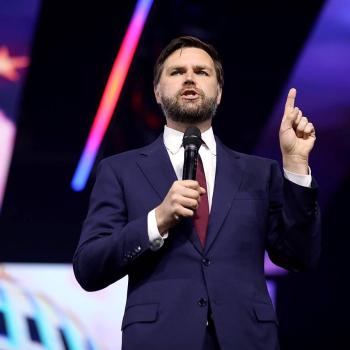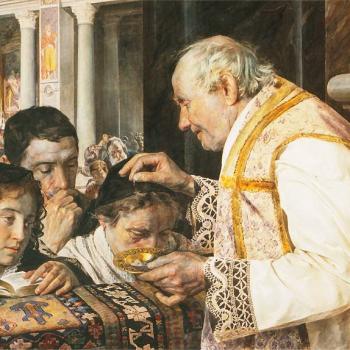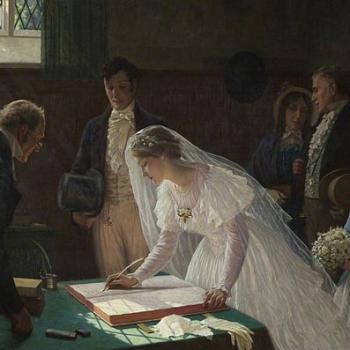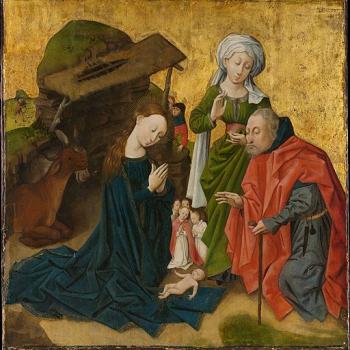A homily for the second Sunday. A beautiful triplet of readings. I really like the reading from Paul, but I could not really see how to work it in with the other two. Writing this was partly influenced by a private detail: last week was the 30th anniversary of the day I proposed. What a long strange trip it has been. As always, thoughts and comments are welcome: help me learn the art of the homily!
On this Sunday the gospel reading is from John. This liturgical year we use cycle C in the lectionary, and the vast majority of the gospel readings in ordinary time will be taken from Luke. But today, the Church instead chooses a reading from the fourth Gospel. The Gospel of John inaugurates the public ministry of Jesus with this story, telling us: “Jesus did this as the beginning of his signs…and so revealed his glory”. As we saw last week, when the Gospel reading described the Baptism of Jesus, today we again see that Jesus’ public ministry will not follow the path one would expect from the Messiah, the promised King of Israel.
His birth was marked by great signs: at Christmas, we heard of the multitude of angels who announced his birth to the shepherds; at Epiphany we heard about the Magi from the East who followed heavenly signs to pay him homage. But the public ministry of Jesus was going to be different. Appearing at the Jordan where John was proclaiming the advent of the Messiah, Jesus did not call attention to himself. Rather, he humbled himself and joined the crowd being baptized by John in preparation for the new kingdom. Jesus had come to establish this kingdom, but it would not be like earthly kingdoms that are forged with violence and tumult. As the reading from Isaiah last week put it, “he shall bring forth justice to the nations, not crying out, not shouting, not making his voice heard in the street. A bruised reed he shall not break, and a smoldering wick he shall not quench.”
In today’s gospel Jesus performed his first sign, turning water into wine. But consider the setting: he did not stand beside the village well, turning water into wine for anyone who approached him. He did not gather a large crowd (think of the miracle of loaves and fishes) and then provide them with abundant wine. Rather, he is one guest among many at a large wedding. He again does not call attention to himself. Indeed, from the way John describes it, only a few guests—Jesus, his mother, his disciples—and a handful of servants knew what had happened. Neither the steward in charge of the feast, nor the groom, the guest of honor, knew. The story would get around: surely the servants would tell the story of great stone jars of water changed to wine. But at the moment Jesus acted quietly, without fanfare, without calling attention away from the bridge and groom, so that his disciples might “begin to believe in him.”
This would slowly change: Jesus’ ministry would attract more attention, the crowds would grow, and so would the opposition. In the end, Jesus would be crucified. Looking back, John frames this first miracle story to point his readers, to point us, forward to the final miracle of Jesus. In the New Testament, the Gospel passage begins “on the third day….”; it ends by telling us that Jesus “revealed his glory.” The final miracle of Jesus, the one which would inaugurate the Kingdom of God, was his resurrection: on the third day God raised him up and he again revealed his glory.
Another important aspect of the gospel today is that it is set at a wedding. In the Old Testament, the prophets frequently used marriage and weddings as symbols to describe the relationship between God and his people. In the first reading today, the prophet Isaiah promises the Israelites, then in exile in Babylon, that their kingdom will be restored. He uses wedding imagery to describe the occasion: “As a young man marries a virgin, your Builder shall marry you; and as a bridegroom rejoices in his bride so shall your God rejoice in you.” He chose this familiar image because a wedding, full of joy and the promise of a better future, made concrete the depths of God’s love for his people.
This image continues in the New Testament. Throughout his ministry , Jesus refers to himself as the bridegroom: he has come to bring to fulfillment the prophecy of Isaiah and claim his bride, the people of God. By starting his public ministry at a wedding, he is in fact heralding the greater celebration to come: the wedding feast of the Lamb in Heaven, when all things are made new in the Kingdom of God.
There was a wedding in Cana of Galilee. At this wedding, with little fanfare, Jesus performed his first miracle, a simple gift to the bride and groom. By changing water into wine he allowed their wedding feast to continue uninterrupted, for friends and family to celebrate their time of joy. Today, in the Eucharist, Jesus brings himself to us in the simple gifts of bread and wine, changing them into his body and blood. In this sacrament we receive a foretaste of the wedding feast of Heaven. Like the disciples, we see his glory. Today, therefore, let us approach the altar with joy and thanksgiving, let us celebrate, knowing how much our God rejoices in us.















